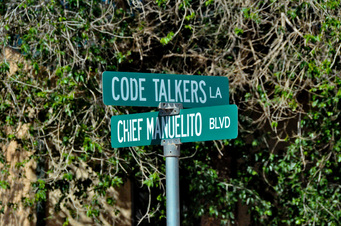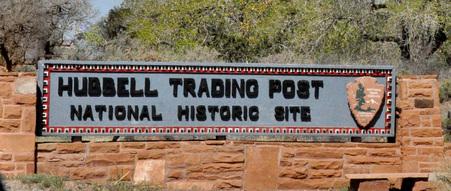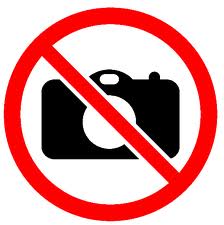
Intersection behind the Chinle Hospital
Before we left Chinle this morning we went in search of the Hospital facility. Marsha’s nephew Andrew and his family will be living in Chinle for the next two years while he works at the Department of Interior staffed Hospital. The hospital is off the main road and is surrounded by housing for the staff. It will certainly be an interesting place to be.
The intersection pictured to the right references the
Navajo Code Talkers, Navajo soldiers who contributed a vital service during World War II of providing an intrinsically secure communication channel: speaking in a language that no one else in the world spoke.
Photos of Chinle Hospital Area (placeholder)
Hubbell Trading Post National Historic Site

An hour after leaving Chinle we were at the
Hubbell Trading Post National Historic Site. See also
Wikipedia. In 1878 John Lorenzo Hubbell purchased this trading post. Family members operated the trading post until it was sold to the National Park Service in 1965. We were disappointed that the trading post itself has not be restored to its original state but rather is operated as a store by the Western National Parks Association. It does, however, retain some of the original features. The real charm of the place is in Hubbell’s 160-acre homestead that was left in its original state. The gem here is the house itself. The ceiling of the central hall is covered with the Indian baskets that Hubbell collected. The walls are covered with the hundreds of the paintings and sketches done by visiting artists who willingly gave their work to Hubbell in thanks for his hospitality. Everywhere you look there are Navajo rugs. Used as blankers, floor, sofa and table coverings. The décor in its entirety elicits a gasp as you enter. Once you adjust you notice the details. The beaded Indian saddlebags placed above the doorways. The dining room table made to order in Cincinnati. Hubbell purchased the table with the profits from sheep’s wool and so asked that the corners of the table and the design on the sideboard include carved rams heads.
The National Park Service has a nice website devoted to the art in the Hubbel Traiding Post titled
Navajo Portraits.
Photos of Hubbell Trading Post (placeholder)
Art and Crafts at the Hubbell Trading Post
There were many different pieces of art throughout the Hubbell Trading Post as well as in the Hubbell family home: paintings, Navajo rugs and blankets, baskets, trays, jewelry. This is a very place to visit if you are interested in American Indian Arts and Crafts.
Paintings at the Hubbell Trading Post
Navajo Rugs
There were several rooms devoted to Navajo Rugs. It was breathtaking to see so many authentic rugs in one place. When Hubbell began trading the Navajo were weaving blankets. These square blankets were used for bedding and worn as a shawl like garment. Hubbell convinced them to weave in rectangular shapes and began selling the Navajo weavings as rugs. His other major contribution to the Navajo rug trade was inadvertent. He loved the color red. The Navajo traditionally used muted tones of grays, browns, and creams. In order to please Hubbell and sell him more rugs they started adding a bit of red and subsequently more and more.
Rugs and Blankets used for a variety of purposes
Patterns for Navajo Rugs
I'm only guessing at this explanation, but I'm going to guess that Navajo rugs were ordered based on a painting of the rug. Below are 20 or so patterns that were offered. There were more. Each of these was an 8"x10" drawing of a rug you could order
Hopi Mesas

The Hopi do not allow photographs to be taken. Ugh...
We left Hubble and drove for an hour to the Hopi Mesas. The treatment of the Native populations by the settlers and U.S. Government was and continues to be deplorable. The Hopi were perhaps dealt the worst hand. Their reservation is on god-forsaken land. The three stone mesas rising above the arid plains. The lands of their sworn enemies the Navajo surround the Hopi reservation. Their remote location far from any major population center precludes the possibility of building a casino that would generate funding. Many Hopi remain in poverty with their beliefs and traditions intact.
They put very little effort into presenting their culture and arts to outsiders.
All of the other Indian Cultural centers that we had visited did an excellent job of presenting their history, culture and art. The Hopi Cultural Center was just depressing. There was little or no information on how to see their villages. Somehow we managed to forge ahead and try to keep a blind eye to the squalor around us. On first mesa we followed the hand written signs to a building were we purchased tickets for a lecture on the Hopi and a walking tour through two villages.
The tour guide in me tried very hard not to keep a running list of all of the “worst practices” of the lecturer/guide and just tried to take in the information. It was difficult. The reward at the end was the walk through the village of Walpi. The village is no longer inhabited full time but continues to be used to celebrations.
Walpi is at the very end of Mesa. Its stone and adobe buildings cling to the rock and hover precariously close to the edges of the cliffs. It is a spectacular setting.
Photos of area around Hopi Reservation (placeholder)
La Posada Hotel

Another hour’s drive and we were in Winslow, Arizona which has two claims to fame. Remember that Eagles Song “Take it Easy” and the line about “Standin on the Corner in Winslow, Arizona”. These days there is statue of a young man with a guitar standing next to a lamppost on that corner and visitors, like us, can stand there like the aging children of the 60’s we are and have their picture taken.
La Posada Hotel was built in the late 1920’s as the last of the great railway hotels built by the Santa Fe Railroad. The hotel was designed by Mary Jane Colter who was the architect responsible for that distinctive melding of arts and crafts and western styles known as park-a-tecture. The Fred Harvey Company ran the hotel. Every train of the time that went between Los Angeles and Chicago stopped at La Posada.
After being closed for 40 years the Hotel underwent restoration in 1997 and is now again a vibrant hotel. We are staying at the local Quality Inn but went to La Posada last night for dinner. Its restaurant, the Turquoise Room, is considered to be the best restaurant in the four corners region. It lived up to its reputation. We had a wonderful elegant and tasty dinner after which we walked around the public rooms of the hotel. The new owners have added contemporary art to the mix and the effect is stunning.
If you find yourselves in Winslow do by all means stay at La Posada and have your photo taken on that particular corner along the “Mother Road”, Route 66.
Photos of La Posada (placeholder)




 RSS Feed
RSS Feed